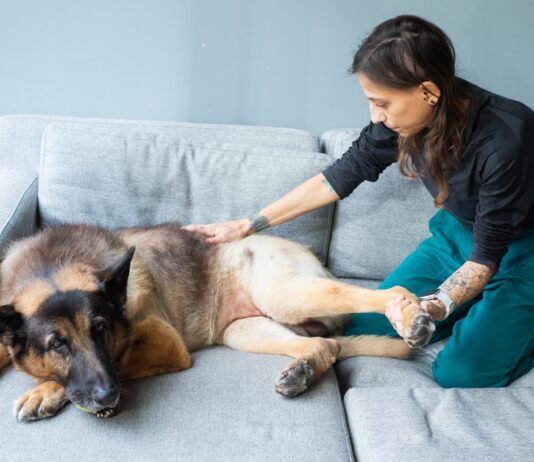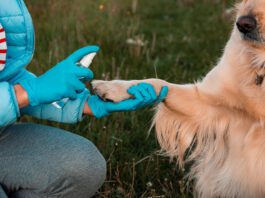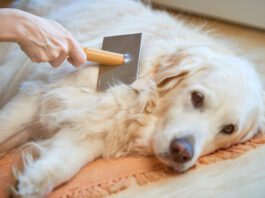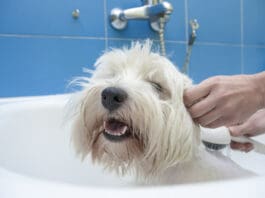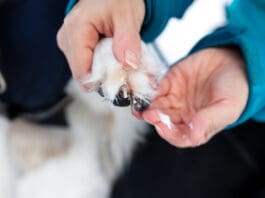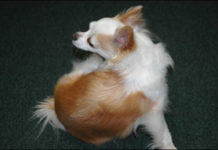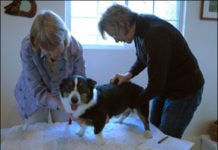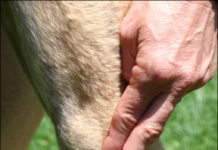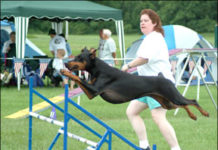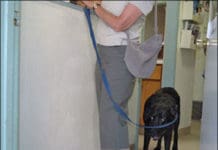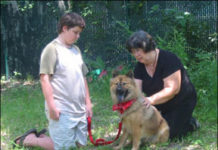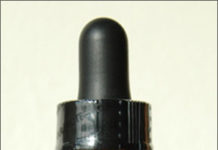Canine Acupressure to Calm High Energy Dogs
These are too-common refrains of guardians of dogs who are bouncing off the walls: "She has way too much energy!" "This dog is out of control!" "I've had enough of this crazy dog, he's a maniac!" You can love your dog to pieces, but if his behavior is unruly, it can be very hard to live with on a steady basis. One of the most common reasons dogs are released to shelters is because they are out of control. Hyperactive dogs are frequently difficult for their owners to enjoy. Surviving this situation may stressful for you, your family, guests - and the dogs themselves. The first step is to have the dog evaluated by your trusted holistic veterinarian, to determine if there is any underlying medical condition. Hyperactivity, also called "hyperkinesis," actually can be the result of a medical condition that is characterized by frantic behavior, incessant movement resulting in exhaustion, a consistent elevated heart rate, panting, loss of weight, vomiting, and increased appetite or loss of appetite. Canine compulsive disorders such as tail-chasing, self-mutilation, and other nonproductive, repetitive behaviors are usually considered forms of hyperactivity.
How to Use Calendula on Dogs
itchy skin: in a clean jar
Chiropractors for Canines
Everyone knows that chiropractors are bone and joint doctors. They help alleviate back pain and other aches by making adjustments that improve skeletal alignment and musculoskeletal function. In recent years, chiropractic adjustments have become popular for dogs, especially those recovering from accidents or injuries. But did you know that chiropractic care can improve a dog’s digestion; speed healing after illness or surgery; treat behavior or mood changes; help alleviate ear infections, urinary incontinence, and allergies; and even correct neurological imbalances? Cheryl Morris, DC (Doctor of Chiro-practic), a chiropractor for humans in Congers, New York, knew something was wrong with Stanley Queue, her five-year-old Scottie. He vomited spontaneously three or four times a day several times a week, and when she palpated his abdomen, his diaphragm felt tight.
Five Accupressure Points for Your Dog’s Health
GB 34 maintains the body's ability to move by keeping the tendons and ligaments supple. Stimulating this point will help minimize physical injuries. This point is known to support emotional balance as well.
■Heart 7 (HT 7)
Healing Your Canine with Energy Medicine and Holistic Dog Care Techniques
Can exposure to color change your health? What about tapping on key acupuncture points or other body parts? And is there any way to focus or concentrate naturally occurring energy so that it has a more therapeutic effect? Veterinarians and other healthcare practitioners who experiment with energy healing deal with these and related questions when they address the “etheric body,” the invisible part of the patient that is also described as the vital or energy body. Improving the etheric body’s energy flow or state, they say, stimulates a self-healing mechanism that encourages the body to repair itself, often in record time. In the past four issues, we’ve described a number of “energy medicine” tools such as homeopathy, flower essences, Reiki, crystals, acupuncture, and therapeutic touch. In this article, the conclusion of this series, we’ll describe several more modalities that can be used alone or in combination with conventional or alternative therapies and are widely considered to be free from adverse side effects.
Canine Earth Energy Healing
Who doesn’t have at least one quartz crystal, turquoise pendant, jade figurine, or amethyst geode? You probably have a strand of beads, too, maybe aventurine, bloodstone, citrine, coral, garnet, or sodalite. What you may not realize is that, according to crystal enthusiasts, these items can help both you and your dog improve your health, balance your emotions, and enhance your quality of life.Whether they’re novelty items or elegant jewelry, crystals – precious and semiprecious gems as well as humble stones and river rocks – have been valued for thousands of years for their healing and aesthetic properties. The more people explore the use of crystals, stones, and gems, the more their dogs, cats, horses, and other animals are likely to benefit from this branch of energy medicine. Your pets can sleep near crystals, wear them, drink water that has been “charged” by crystals, and in other ways receive the energy that is said to be unique to each type of stone.
How Homeopathy Works for Your Dog
Two dogs have itchy skin and small open sores on their legs. One goes to a conventional veterinarian and receives antibiotics, steroids, or other symptom-suppressing drugs. The other goes to a veterinary homeopath, who studies the dog’s symptoms and asks all kinds of questions about his behavior and actions while looking things up in a book or computer. The homeopath selects a remedy, gives the dog a single dose, and instructs the owner to wait, watch, and report back. The remedy is chosen not because it reduces or eliminates the dog’s symptoms but because by itself, when given to a healthy patient, it actually produces those same symptoms. And the remedy is so dilute that it contains not a single molecule of the substance on the label. Welcome to the world of homeopathy, one of the most interesting and controversial alternative therapies and forms of “energy medicine.”
Canine Energy Healing Techniques
Energy medicine, once so exotic that it was dismissed out of hand by America’s physicians and veterinarians, is now going mainstream. In addition to the canine therapies described last month, energy healing techniques such as flower essences, animal communication, and kinesiology are used by holistic veterinarians in the U.S. and around the world. Understanding what these therapies are and how they work will help you decide which energy therapies might be appropriate for your canine companion.
Alternative Views on Holistic Dog Care
We asked several Canine Veterinarians who use complementary and/or alternative medicine: “What are the most basic precepts of ‘holistic dog care’ that dog owners should understand and employ? The points that you want them to absorb if they are to become your regular clients? What dog care practices do you consider to be the bedrock of a vibrant wellness program, and why?” As one might expect from individuals who have explored highly divergent paths in holistic medicine, their answers were idiosyncratic.
Frequently Used Canine Healing Methods for Injured Dogs
We call it the spark of life for good reason. From birth to death, all living creatures generate and transmit energy. Entire healing therapies, some of them thousands of years old, have been built around energy. Once dismissed by Western science as impossible or ridiculous – and still viewed with suspicion by conventional physicians and veterinarians – energy medicine is slowly gaining acceptance in the United States. Several energy therapies are taught in American universities or are used by a growing number of healthcare practitioners. Can energy therapies help your dog? The descriptions and resources provided here may help you decide.
Bee Products Have a Special Meaning for Dogs
Bees may sting, but they create some of the world's most valuable, versatile products. Honey, bee pollen, royal jelly, beeswax, propolis, and even the venom from bee stings are all touted for their human health benefits and many experts say that dogs derive the same advantages.
Ways to Use Lemon Balm on Dogs
Next month, on May 6, the first day of National Herb Week, lemon balm (Melissa officinalis) becomes Herb of the Year for 2007. A dog-friendly plant with a distinctive lemon-mint fragrance and flavor, lemon balm is best known as a nervine, a calming herb that soothes and relaxes. It's also a digestive aid that neutralizes gas in the stomach and intestines.


